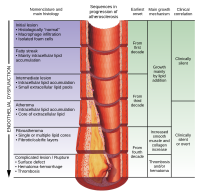
Photo from wikipedia
Vascular calcification is commonly observed in chronic kidney disease. The mechanism of how the calcification signal from endothelial cells is transmitted to vascular smooth muscle cells (VSMCs) remains unknown. The… Click to show full abstract
Vascular calcification is commonly observed in chronic kidney disease. The mechanism of how the calcification signal from endothelial cells is transmitted to vascular smooth muscle cells (VSMCs) remains unknown. The aim of the present study was to investigate whether exosomes from HUVECs (HUVEC-Exos) could regulate VSMC calcification and its potential signaling pathway. HUVEC-Exos were isolated from HUVECs under no phosphorus (NP) and high phosphorus (HP) conditions. Alizarin Red S staining and calcium (Ca) content analysis were carried out to detect calcification in VSMCs. Proteomics analysis was carried out to detect the differential expression of exosomal proteins. Protein and mRNA levels were measured by western blot analysis and reverse transcription-quantitative PCR (RT-qPCR). Exosomes derived from HP-HUVECs promoted the calcification of VSMCs, as assessed by Alizarin Red S staining, alkaline phosphatase activity assays, Ca content measurements and the increased expression of runt-related transcription factor 2 and osteopontin. Proteomic analysis detected the upregulation of STAT1 in HP-exosomes from HUVECs (HUVEC-Exos) compared with NP-HUVEC-Exos, which was also confirmed by western blot analysis and RT-qPCR. Inhibition of STAT1 expression in VSMCs using fludarabine or knockdown of STAT1 expression using small interfering RNA alleviated the calcification of VSMCs. Furthermore, lithium chloride (Wnt activator) reversed the protective effect of STAT1 inhibition on VSMC calcification, while Dickkopf-1 (Wnt inhibitor) exerted the opposite effect, suggesting that activation of the Wnt/β-catenin signaling pathway was involved in STAT1-mediated VSMC calcification. In conclusion, the present results indicated that exosomal STAT1 derived from HP-treated HUVECs could promote VSMC calcification, and activation of the Wnt/β-catenin pathway may be a potential mechanism of the VSMC calcification promoted by exosomes.
Journal Title: International Journal of Molecular Medicine
Year Published: 2022
Link to full text (if available)
Share on Social Media: Sign Up to like & get
recommendations!